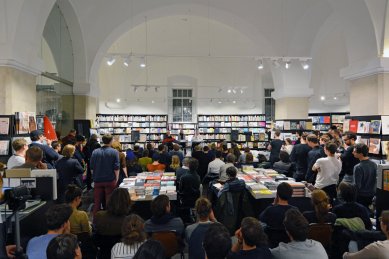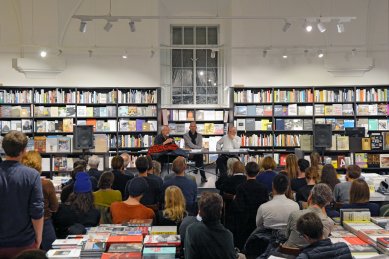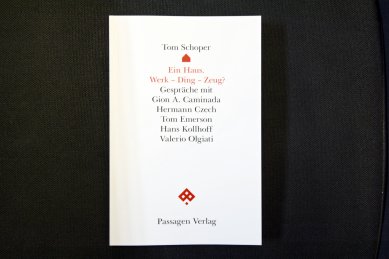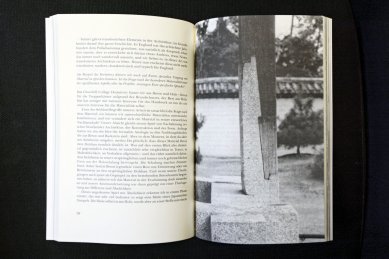
House - work, thing, tool? - presentation of the publication
On Monday, October 24, 2016, the publication by the Dresden architect and theorist Tom Schoper was presented at the Walther König bookstore in Vienna's Museumsquartier. His latest title is called House - Work, Thing, Tool?
Tom Schoper, who is an assistant professor at Dresden University of Technology, published the book On the Identity of Architecture six years ago with Transcript Verlag, exploring four basic concepts of architectural design, where he “loudly reminded of the thoughts of long-dead architects.” This time, in the book published by the Viennese publisher Passagen Verlag, he chose to interview five contemporary architects (Gion A. Caminada, Hermann Czech, Tom Emerson, Hans Kollhoff, Valerio Olgiati), two of whom appeared at the evening book presentation at MQ. Schoper invited Swiss architect Valerio Olgiati, who is a professor at the Accademia di Architettura in Mendrisio, Ticino, and Viennese architect Hermann Czech, who is a visiting professor at the local Academy of Fine Arts and Harvard University.
Each of the five architects received the same question from Schoper at the beginning of the interview, a question already posed by Martin Heidegger in The Origin of the Work of Art (1935) in an attempt to seek the origin of the architectural work through philosophy. Heidegger himself moved in circles in his interpretation. The evening discussion at MQ also had no aspiration to find a universal answer, as the chosen group of architects is sufficiently broad for each to have completely different sources of inspiration.
Czech compared the situation over the past half-century. Since the 1970s, architects have hopefully looked to "quasi-philosophy" to help better defend the aesthetic aspect of their designs. This "philosophical phenomenon" came from postmodern America, which, lacking deeper historical roots, began to formulate theoretical considerations leading to a convoluted deconstruction. Earlier, architects managed without deep philosophical reflections. Today, journalists ask architects not only about the main ideas of their works but also their opinions on politics, refugees, Islam, ecology, and other fields, of which they know only slightly more than cleaners do. The ideas of the interwar avant-garde are completely dead today. Czech feels much closer to Loos's theory, observed from the ordinary work of craftsmen, for whom quality workmanship was natural. The real theoretical boom in Austria only occurred after World War II with the arrival of magazines, television, and other media. From Czech's perspective, architecture is what is actually realized, and for it to be built, society must at least partially accept it, thus leaving its imprint on architecture.
In contrast, Olgiati's buildings tell nothing. For him, the primary aspect is the form that refers only to itself. In a nod to this year's Venice Biennale, he also fears that in today's times it is impossible to create "Accidental space" as Christian Kerez attempted. During Olgiati's studies at ETH, values were being dismantled, and he compared the significance of all elements influencing architecture. Today's fast-paced world forces constant novelty, causing architects to embed even more atmosphere, esotericism, stories, and inflated expectations into their projects. In his own work, Olgiati has retreated into a closed world that does not reference his predecessors. With the help of Nietzsche's quote: “Form is the idea itself.”, which inverts Platonism, he seeks a timeless form and structure that should be an idea in itself and convey concepts without the need for further interpretation.
At the conclusion of the discussion, Czech shifted from deep thoughts to questions about architectural competitions, comparing them (from the perspective of architectural stars) to purchasing a car without knowing its brand in advance. Car enthusiast Valerio Olgiati added that he would never decide to buy a car based on pictures alone, but only based on a test drive.
We can be sure that the remaining three architects with whom Tom Schoper conducted the book interviews will have their own views on creation.
More Information >
Tom Schoper, who is an assistant professor at Dresden University of Technology, published the book On the Identity of Architecture six years ago with Transcript Verlag, exploring four basic concepts of architectural design, where he “loudly reminded of the thoughts of long-dead architects.” This time, in the book published by the Viennese publisher Passagen Verlag, he chose to interview five contemporary architects (Gion A. Caminada, Hermann Czech, Tom Emerson, Hans Kollhoff, Valerio Olgiati), two of whom appeared at the evening book presentation at MQ. Schoper invited Swiss architect Valerio Olgiati, who is a professor at the Accademia di Architettura in Mendrisio, Ticino, and Viennese architect Hermann Czech, who is a visiting professor at the local Academy of Fine Arts and Harvard University.
Each of the five architects received the same question from Schoper at the beginning of the interview, a question already posed by Martin Heidegger in The Origin of the Work of Art (1935) in an attempt to seek the origin of the architectural work through philosophy. Heidegger himself moved in circles in his interpretation. The evening discussion at MQ also had no aspiration to find a universal answer, as the chosen group of architects is sufficiently broad for each to have completely different sources of inspiration.
Czech compared the situation over the past half-century. Since the 1970s, architects have hopefully looked to "quasi-philosophy" to help better defend the aesthetic aspect of their designs. This "philosophical phenomenon" came from postmodern America, which, lacking deeper historical roots, began to formulate theoretical considerations leading to a convoluted deconstruction. Earlier, architects managed without deep philosophical reflections. Today, journalists ask architects not only about the main ideas of their works but also their opinions on politics, refugees, Islam, ecology, and other fields, of which they know only slightly more than cleaners do. The ideas of the interwar avant-garde are completely dead today. Czech feels much closer to Loos's theory, observed from the ordinary work of craftsmen, for whom quality workmanship was natural. The real theoretical boom in Austria only occurred after World War II with the arrival of magazines, television, and other media. From Czech's perspective, architecture is what is actually realized, and for it to be built, society must at least partially accept it, thus leaving its imprint on architecture.
In contrast, Olgiati's buildings tell nothing. For him, the primary aspect is the form that refers only to itself. In a nod to this year's Venice Biennale, he also fears that in today's times it is impossible to create "Accidental space" as Christian Kerez attempted. During Olgiati's studies at ETH, values were being dismantled, and he compared the significance of all elements influencing architecture. Today's fast-paced world forces constant novelty, causing architects to embed even more atmosphere, esotericism, stories, and inflated expectations into their projects. In his own work, Olgiati has retreated into a closed world that does not reference his predecessors. With the help of Nietzsche's quote: “Form is the idea itself.”, which inverts Platonism, he seeks a timeless form and structure that should be an idea in itself and convey concepts without the need for further interpretation.
At the conclusion of the discussion, Czech shifted from deep thoughts to questions about architectural competitions, comparing them (from the perspective of architectural stars) to purchasing a car without knowing its brand in advance. Car enthusiast Valerio Olgiati added that he would never decide to buy a car based on pictures alone, but only based on a test drive.
We can be sure that the remaining three architects with whom Tom Schoper conducted the book interviews will have their own views on creation.
More Information >
The English translation is powered by AI tool. Switch to Czech to view the original text source.




0 comments
add comment












